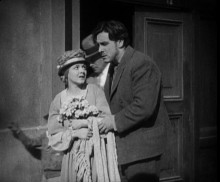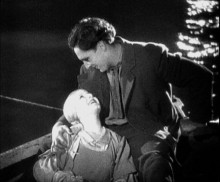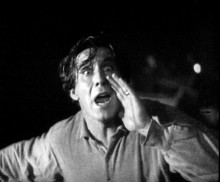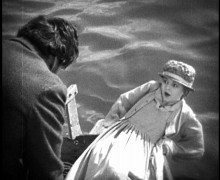F.W. Murnau’s Sunrise: A Song of Two Humans (1927) has occasionally been called the greatest movie of all time—and while I’m not foolish enough to make such an absolute claim for any film, I will say I can’t think of a better one. I also do believe it to be the greatest silent film ever made—the one that fully justifies mourning the passing of that particular art form. It’s a simple story—of a certain psychological depth—that could even be called melodramatic, with its tale of a country husband (George O’ Brien) who is so bewitched by a city woman (Margaret Livingston) that she convinces him to drown his wife (Janet Gaynor) on a boat trip. That, however, is just the beginning of the story, and in no way takes into account either the film’s humanity or the genius of its cinematic quality.

Sunrise is one of those movies that I’d read about for years without actually seeing. This wasn’t entirely circumstantial either. In all honesty—despite glowing endorsements and the evocative stills reproduced in book after book of the film—I simply could not get that enthused by the story. That changed in 1999 when I was reviewing the laserdisc release for Scarlet Street magazine. I don’t think I’ve ever been so surprised at how stupid I’d been to avoid a movie. I do know that I opened my review by noting that it was perhaps a sad commentary on modern film that the best movie I’d seen all year was made in 1927. Since then I’ve seen it many times and my feeling is that I’m in the presence of a masterpiece on every level.

It’s not difficult to explain all the craft and creativity that makes the film special. The artistry of the studio sets is apparent even in still photos. That Murnau created an entire world is easy to see. The technical breakthroughs like the traveling matte shot—the unreality of which only makes it that much more effective—are evident without much effort. Even the fact that the smallest detail has been treated with special care—like the intertitle “Couldn’t she get drowned?” sliding off the screen as if sinking in water—is there for anyone with eyes to see. All of this factors into what helps to make Sunrise not just a great film, but something truly special. Yet it doesn’t explain what makes it a wholly compelling—even magical—movie experience. That’s a lot more slippery.

Words cannot adequately convey the experience of Sunrise—and God knows, many words (including some of my own) have attempted it. It’s partly the technical side, but it’s the human aspects of the film that make it all work. At the center is a fearless, unexpected and remarkable performance from George O’Brien. Nothing in O’Brien’s lengthy filmography suggests the unabashedly human performance he gives in this film. He obviously completely trusted Murnau and gave himself over to him and his concept of how to play “The Man” in Sunrise. Janet Gaynor as “The Wife” is very nearly as good, but her performance is less of a revelation. Their performances are another part of the answer.

There’s more, however, and I think some of it has to do with the fact that the film is silent—or, more correctly, that it doesn’t have dialogue, because it does have a synchronized score and sound effects. I’m not one of those who generally decries the passing of the silent movie. In the main, I far prefer talkies to silents. But Sunrise seems to me to be a film that exists in a world all its own—yet one in which our own world can be seen and felt—and that it could only exist without words. Dialogue would be a destructive intrusion—and it might very well make the grand, larger-than-life passions seem ridiculous, which they don’t seem in the least in the film as it stands.
Have I explained the greatness of Sunrise? No, not in the least. I have at best offered some observations and signposts. Nothing will explain it or the experience of it. It simply has to be seen—and that is as it should be.




Well, I came to Sunrise im much the same way you did. Except by proxy.
I, too, had read about it for years… but had never been moved to see it. Foremost, I never “got” Janet Gaynor I know she was quite the star…but, Garbo, she wasn’t . And George O’Brien? Please.
But, because of your review of the DVD in Scarlet Street, I finally tracked it down. I suppose I should have trusted Murnau. It is a dammned near perfect film. It is a world of it’s own.
So, a belated thanks for getting me away from the reams of copy about this film and to the film itself. Forget about CGI, 3D, hell- even color and sound. If your readers have a more than passing interest in film- this one needs to watched.
But, because of your review of the DVD in Scarlet Street, I finally tracked it down. I suppose I should have trusted Murnau. It is a dammned near perfect film.
I’m glad to have been the instrument that caused you to look, but did I review the DVD? I only remember reviewing the laserdisc.
Forget about CGI, 3D, hell- even color and sound. If your readers have a more than passing interest in film- this one needs to watched.
Actually, it uses sound, just not dialogue — and it’s one of the most effective uses of music and limited sound effects from that era. But you’re right about it needing to be seen. I’m very curious about the turnout on this one. Though a few people have asked if and when we were going to run a silent film, that may play against it. Tuesday will provide an answer.
Well, you must forgive me if I’ve confused the laser disc review with the DVD review. It has been a while.
I know the film had sound. I just tend to regard silent as lacking “talk”.
I’m curious about the turnout, too. I think you might be pleasantly surprised.
I think you might be pleasantly surprised.
I’m often surprised. Sometimes pleasantly.